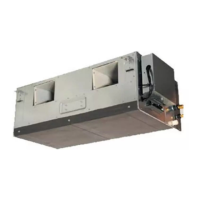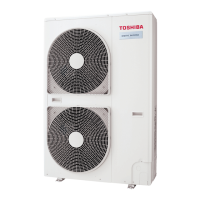Why does my Toshiba Air Conditioner show a phase sequence error?
- DDonna PetersAug 25, 2025
If your Toshiba Air Conditioner displays a phase sequence error, it is caused by an abnormal phase sequence of the 3-phase power supply.

Why does my Toshiba Air Conditioner show a phase sequence error?
If your Toshiba Air Conditioner displays a phase sequence error, it is caused by an abnormal phase sequence of the 3-phase power supply.
What does it mean if my Toshiba RAV-SM1403DT-A displays an outdoor unit low-pressure system error?
If your Toshiba Air Conditioner displays a low-pressure system error, the Ps pressure sensor error was detected, or low-pressure protective operation was activated.
What does an outdoor unit current detect circuit error mean on my Toshiba RAV-SM1403DT-A Air Conditioner?
If your Toshiba Air Conditioner is showing an error with the outdoor unit current detect circuit, it means abnormal current was detected in AC-CT, or a phase loss was detected.
What does a heat sink sensor error mean on my Toshiba RAV-SM1403DT-A?
A heat sink sensor error on your Toshiba Air Conditioner means that the temperature sensor of the IGBT heat sink detected an abnormal temperature.
What does an indoor unit heat exchanger sensor (TCJ) error mean for my Toshiba RAV-SM1403DT-A Air Conditioner?
An error with the indoor unit heat exchanger sensor (TCJ) on your Toshiba Air Conditioner indicates an open-circuit or short-circuit of the heat exchanger sensor (TCJ) was detected, possibly due to an issue with the Indoor P.C. board.
What does an indoor unit heat exchanger sensor (TC) error mean on my Toshiba Air Conditioner?
If your Toshiba Air Conditioner shows an error with the indoor unit heat exchanger sensor (TC), it indicates an open-circuit or short-circuit of the heat exchanger sensor (TC) was detected. The cause may be the Indoor P.C. board.
What does an outdoor unit temp. sensor (TE/TS) error mean on my Toshiba RAV-SM1403DT-A Air Conditioner?
If your Toshiba Air Conditioner displays an error related to the outdoor unit temp sensor (TE/TS), it indicates an open-circuit or short-circuit of the heat exchanger temp sensor was detected, potentially due to the Outdoor P.C. board.
What does an outdoor unit outside air temp. sensor error mean on my Toshiba Air Conditioner?
If your Toshiba Air Conditioner displays an error related to the outdoor unit outside air temp. sensor, it indicates an open-circuit or short-circuit of the outdoor air temp. sensor was detected, potentially due to the Outdoor P.C. board.
What does an indoor unit room temp. sensor (TA) error mean on my Toshiba RAV-SM1403DT-A?
If your Toshiba Air Conditioner displays an error related to the indoor unit room temp. sensor (TA), it indicates an open-circuit or short-circuit of the room temp. sensor (TA) was detected. The cause may be the Indoor P.C. board.
| Brand | Toshiba |
|---|---|
| Model | RAV-SM1403DT-A |
| Category | Air Conditioner |
| Language | English |
Covers critical warnings for installation, operation, and repair/movement safety.
Covers important cautions for installation and operation safety.
Identification of parts for the indoor air conditioner unit.
Overview of the separate sold remote controller.
Identification of parts for the outdoor air conditioner unit.
Explanation of indicators and symbols on the remote controller display.
Description of buttons and functions in the remote controller operation section.
Steps to take before starting the air conditioner for the first time.
Procedures for initiating and safely stopping the air conditioner's operation.
Guide to setting up different timer modes for operation.
Instructions for canceling an active timer setting.
Steps to activate the power saving mode of the air conditioner.
How to disable the power saving mode.
Detailed instructions for configuring power saving settings.
Advice on maintaining efficiency and reducing energy consumption.
Understanding how the protective device stops operation and what to do.
Procedure for cleaning the air filters and resetting the indicator.
Guidelines for cleaning the remote controller safely.
Recommended checks for long-term use and preparing for storage.
Explanation of the 3-minute protection and power failure handling.
Details on preheating, warm air control, and defrosting.
Recommended temperature and humidity ranges for optimal performance.
Guidance on suitable and unsuitable places for installing the unit.
Precautions and requirements for electrical connections and grounding.
Steps to check before contacting service for common problems.
Explanations for noises, smells, or mist that are not actual failures.











